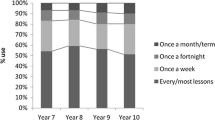Abstract
This study examines the differences between teachers' and students' perceptions of textbook usage in the science classroom. Four categories of use were identified: teacher directed student activities; teaching/studying guidance; as a source of information for the user and as preparation for assessment. The results of the study show that differences do occur between teachers and students with respect to their perceptions of the extent to which textbooks are used in the classroom and the purposes for which they are used, namely as a teaching/studying guide and as preparation for assessment. The findings of the study should be important to all those who use, write and publish high school science textbooks.
Similar content being viewed by others
References
Ade-Ridder, L. (1989). Textbook decisions: Making an informed choice.Family Relations, 38(2), 231–240.
Chiappetta, E.L., Sethna, G.H. & Fillman, D.A. (1991). A quantitative analysis of high school chemistry textbooks for scientific literacy themes and exposing learning aids.Journal of Research in Science Teaching, 28(10), 939–951.
Cho, H., Kahle, J.B. & Nordland, F.H. (1985). An investigation of high school textbooks as sources of misconceptions and difficulties in genetics and some suggestions for teaching genetics.Science Education, 69(5), 707–719.
Cook, A. & Tulip, D. (1992). The importance of selected textbook features to science teachers.Research in Science Teaching, 22, 91–100.
Davey, B. (1988). How do classroom teachers use their textbooks?Journal of Reading, 31, 340–345.
Gottfried, S.S. & Kyle, W.C. (1992). Textbook use and the biology education desired state.Journal of Research in Science Teaching, 29(1), 35–49.
Hare, V.H., Rabinowitz, M. & Schieble, K.M. (1989). Text effects on main idea comprehension.Reading Research Quarterly, 23(1), 72–88.
Kamm, A. & Taylor, B. (1966).Books and the teacher. London: University of London.
Kuhn, T.S. (1970).The structure of scientific revolutions. (2nd ed.) Chicago: University of Chicago Press.
Isaac, S. & Michael, W.B. (1985).Handbook in research and evaluation. (2nd ed.) San Diego: Edits Publishers.
Laws, K., Horsley, M., Young, C. & Downey, M. (1990).Textbook availability and usage in N.S.W. Non-government secondary schools, a report of the textbooks in N.S.W. Secondary schools project. Sydney: School of Teaching and Curriculum Studies, The University of Sydney.
Mann, C.F. (1981). What's the use of a textbook?Physics Education, 16, 70–73.
Morris, A. & Stewart-Dore, N. (1987).Learning to learn from text: Effective reading in the content areas. Sydney: Addison Wesley.
Muther, C. (1985). What every textbook evaluator should know.Education Leadership, 42(7), 6–8.
Ormiston-Smith, H. (1993). An alternative model for textbook formation.Research in Science Education, 23, 222–227.
Roth K. & Anderson, C. (1988). In P. Ramsden (Ed.),Improving learning: New perspectives, London: Kogan Page.
Ruis, S.P. (1988). Something's wrong with chemistry textbooks.Journal of Chemical Education, 65, 720–721.
Spiegel, D.L. & Wright, J.D. (1984, April). Biology teachers' preferences in textbook characteristics.Journal of Reading, 624–628.
Shymansky, J.A., Yore, L.D. & Good, R. (1991). Elementary school teachers' beliefs about and perceptions of elementary school science, science reading, science textbooks, and supportive instructional factors.Journal of Research in Science Teaching, 28(5), 437–454.
Tulip, D. & Cook, A. (1991). A comparison of author intentions and student perceptions about textbook characteristics.Research in Science Education, 21, 313–319.
Vachon, M.K. & Haney, R.F. (1983). Analysis of concepts in an eighth grade science textbook.School Science and Mathematics, 83(3), 236–245.
Wellington, J. (1989), Skills and processes in science education: an introduction. In J. Wellington (Ed.)Skills and processes in science education: a critical analysis. London: Routledge.
Woodward, A. (1988). Textbooks: Less than meets the eye.Journal of Curriculum Studies, 19(6), 511–526.
Yager, R.E. (1983). The importance of terminology in teaching K-12 science.Journal of Research in Science Teaching, 20, 577–588.
Yore, L.D. (1991). Secondary science teachers' attitudes toward and beliefs about science reading and science textbooks.Journal of Research in Science Teaching, 28(1), 55–72.
Author information
Authors and Affiliations
Additional information
Specializations: science education.
Rights and permissions
About this article
Cite this article
Tulip, D., Cook, A. Teacher and student usage of science textbooks. Research in Science Education 23, 302–307 (1993). https://doi.org/10.1007/BF02357074
Issue Date:
DOI: https://doi.org/10.1007/BF02357074




